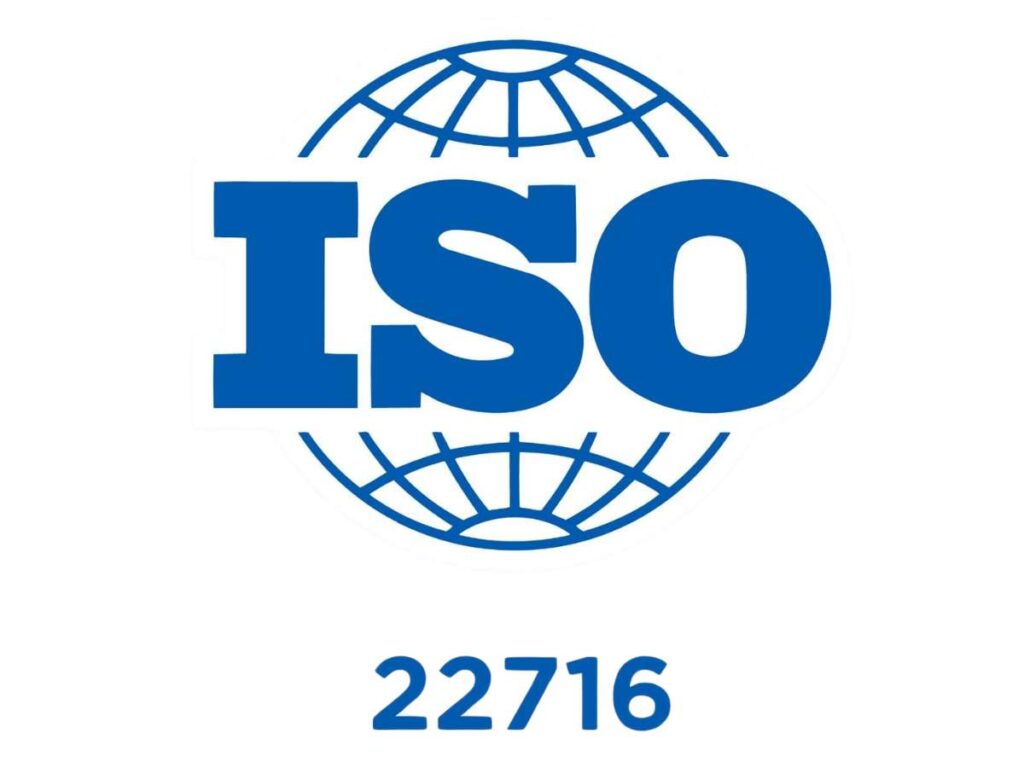What is ISO 22716 in Skincare?

Author: Tommy Tang | Founder at Ridgepole
Hi, I'm Tommy Tang, here to share my expertise in skincare with you.
Table of Contents
Many brands struggle with understanding and implementing GMP requirements, leading to costly mistakes. The good news?
Compliance doesn’t have to be complicated when you know what steps to take.
As a GMP consultant specializing in skincare manufacturing, I’ve guided businesses through ISO 22716 certification, helping them streamline operations while ensuring full compliance.
In this guide, I’ll break down the standard into actionable steps. You’ll learn what ISO 22716 is, how it applies to your business, and the key elements of quality control, documentation, and operational efficiency.
By the end, you’ll have a clear roadmap for compliance success.
So, let’s dive in!
1. What is ISO 22716 in Skincare?
The skincare industry is highly regulated to ensure product safety, quality, and consumer protection. One of the most critical international standards in cosmetics manufacturing is ISO 22716, which provides guidelines on Good Manufacturing Practices (GMP) for skincare and cosmetic products.
This standard is recognized globally and is essential for brands that want to ensure their products are safe, high-quality, and legally compliant in different markets. Whether you’re manufacturing creams, serums, or cleansers, ISO 22716 lays out the best practices for production, quality control, storage, and distribution.
For businesses, adopting ISO 22716 is not just about compliance—it’s about building trust, minimizing risks, and ensuring product consistency.
2. Benefits of ISO 22716 Certification for Skincare Companies
Achieving ISO 22716 certification offers significant advantages for skincare companies. It ensures that manufacturing processes meet international standards, minimizing risks and improving overall product quality.
Enhanced Product Safety and Quality
The standard ensures strict quality control at every stage of production, from raw materials to finished products. This reduces the risk of contamination, defects, and inconsistencies in formulations. Companies can maintain a high level of product safety and consumer trust.
Increased Brand Credibility and Consumer Trust
Certification demonstrates a company’s commitment to quality, safety, and transparency. Consumers and retailers are more likely to choose brands that follow recognized manufacturing standards. This competitive edge can help build a stronger reputation in the industry.
Reduced Risk of Product Recalls and Legal Issues
Implementing ISO 22716 minimizes errors and ensures proper handling of non-conforming products. By following strict GMP guidelines, businesses can prevent costly recalls, lawsuits, and reputational damage. This proactive approach saves time, money, and resources in the long run.

3. Key Components of ISO 22716
ISO 22716 sets essential Good Manufacturing Practices (GMP) for skincare production, ensuring product safety, quality, and compliance. Below are its key components:
- Personnel – Employees must follow strict hygiene standards and undergo regular training. Proper education ensures consistent compliance and minimizes production errors.
- Premises – Facilities should be clean, organized, and designed to prevent contamination. Dedicated spaces for production, storage, and testing help maintain safety and efficiency.
- Equipment – All machinery must be properly maintained, calibrated, and cleaned regularly. This ensures consistent product quality and prevents cross-contamination.
- Raw Materials & Packaging – Strict sourcing, labeling, and storage procedures prevent contamination. Packaging must protect product integrity and comply with regulatory requirements.
- Production – Each manufacturing step must be controlled and documented to ensure consistency. Batch records improve traceability and reduce quality control risks.
- Finished Products – Quality control tests must be conducted before product release. Proper storage conditions help maintain product stability and effectiveness.
- Quality Control Laboratory – Testing must be conducted to confirm that products meet specifications. If third-party labs are used, they must follow ISO 22716 guidelines.
- Non-Conforming Products – Any defective products must be identified, segregated, and analyzed. Corrective actions help prevent recurrence and maintain compliance.
- Waste Management – Proper disposal of waste prevents contamination and protects the environment. Businesses must follow local waste disposal regulations to avoid legal issues.
- Subcontracting – External manufacturers must comply with ISO 22716 standards. Regular audits and clear agreements ensure product quality and regulatory adherence.
- Deviations & Change Control – Any changes in production, materials, or processes must be reviewed. Proper documentation and impact assessments help maintain product safety.
- Complaints & Recalls – A system must be in place to handle complaints and recalls efficiently. Investigating issues helps prevent future occurrences and protects brand reputation.
- Internal Audits & Documentation – Regular audits identify compliance gaps and areas for improvement. Detailed record-keeping ensures transparency and regulatory compliance.

4. Implementation Process of ISO 22716 in Skincare Companies
Implementing ISO 22716 in skincare manufacturing requires a structured approach to ensure compliance with Good Manufacturing Practices (GMP). Below are 5 key steps to successfully implement ISO 22716:
Conduct a Gap Analysis
Businesses must first assess their current manufacturing processes to identify areas that do not meet ISO 22716 requirements. This evaluation helps create a clear action plan for compliance improvements. Addressing these gaps early prevents costly mistakes and ensures a smoother transition.
Develop Standard Operating Procedures (SOPs)
Clear and detailed SOPs must be established for every stage of manufacturing, from raw material handling to product distribution. These procedures ensure consistency, improve efficiency, and minimize risks of contamination or errors. Proper documentation of SOPs is essential for audits and regulatory checks.
Train Employees on GMP Compliance
Staff must be regularly trained on hygiene, safety protocols, and quality control measures. Training ensures that employees follow proper procedures and understand their role in maintaining compliance. A well-trained workforce reduces human error and enhances overall product quality.
Implement a Strong Quality Control System
Quality control must be integrated at every stage of production, with regular testing and inspections. Each batch should be assessed to verify that it meets safety and performance standards before market release. A strong quality control process helps detect potential issues early and prevent costly recalls.
Maintain Proper Documentation and Audits
Accurate record-keeping is crucial for ensuring traceability and demonstrating compliance. Businesses must maintain detailed logs of production processes, equipment maintenance, and staff training. Regular internal audits help identify areas for improvement and ensure ongoing adherence to ISO 22716.
5. Challenges in Adopting ISO 22716 Standards
While ISO 22716 certification offers many benefits, implementing it can present challenges for skincare companies. Businesses must overcome obstacles related to cost, training, and operational adjustments to ensure compliance.
- High Implementation Costs – Upgrading facilities, training staff, and improving quality control require significant investment. While costly upfront, compliance prevents expensive regulatory issues.
- Employee Resistance to Change – New GMP protocols can disrupt workflows, leading to resistance. Proper training and communication help ensure a smooth transition.
- Complex Documentation Requirements – Detailed record-keeping for materials, production, and audits is time-consuming. However, accurate documentation is essential for compliance and traceability.
- Ongoing Monitoring and Maintenance – Compliance isn’t a one-time effort; businesses must regularly update procedures and conduct audits. Dedicated resources are needed to sustain GMP standards.
6. ISO 22716 vs. Other Cosmetic GMP Standards
Understanding the differences between these standards helps skincare brands determine which certification aligns best with their target markets, regulatory requirements, and operational goals. Below is a comparison of ISO 22716 against other major cosmetic GMP standards.
| Criteria | ISO 22716 | FDA GMP (US) | ASEAN GMP | ISO 9001 |
| Regulatory Recognition | Globally recognized, aligns with EU and FDA regulations | US-specific, regulated under the Federal Food, Drug, and Cosmetic Act | Recognized in ASEAN countries for cosmetic safety | Global quality management standard, not specific to cosmetics |
| Scope | Covers entire manufacturing process including storage and distribution | Focused on manufacturing and labeling compliance | Ensures safe cosmetic production practices | General quality management principles across industries |
| Focus Areas | Quality control, hygiene, personnel, equipment, and production process | Product safety, contamination prevention, and labeling accuracy | Personnel training, raw material handling, and facility requirements | Customer satisfaction, continuous improvement, and process control |
| Market Applicability | Accepted in EU, US, and most international markets | Mandatory for products sold in the US | Applicable in Southeast Asian markets | Applies to multiple industries, including cosmetics |
| Documentation Requirements | Detailed documentation required for traceability and audits | Requires records of ingredients, processes, and quality checks | Comprehensive but less strict than ISO 22716 | Emphasizes process improvement but not cosmetic-specific GMP |
| Compliance Enforcement | Voluntary but often required for international trade | Mandatory for compliance with US law | Enforced by regional regulatory bodies | Voluntary but beneficial for brand reputation |
For skincare brands looking to expand internationally, ensure product safety, and maintain credibility, choosing the right GMP standard is a crucial business decision.
Conclusion
I know that implementing ISO 22716 may seem challenging at first, but the long-term rewards make it well worth the effort. Whether you’re launching a new skincare brand or scaling an existing one, aligning with these standards builds trust, credibility, and long-term success.
At Ridgepole, we understand the complexities of skincare manufacturing and take pride in delivering high-quality, GMP-compliant products that meet ISO 22716 standards. We don’t just manufacture skincare—we help brands bring their unique formulations to life with precision and care.
Let’s take your skincare business to the next level. Contact us today, and let’s create something exceptional together!
Quick Quote
Own Your Private Label Cosmetic Line Is No Longer Difficult Here!
Insights
Sorry, we couldn't find any posts. Please try a different search.
It's Time to Expand Your Brand!

Get Your Right Products, Right Now At Ridgepole.




